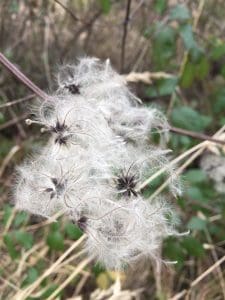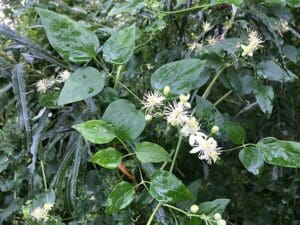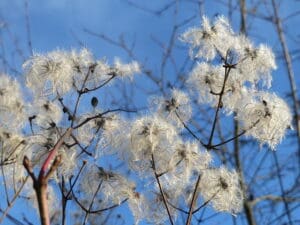Clematis / Summer / Autumn / Inedible
Clematis vitalba, often called Traveller’s Joy or Old Man’s Beard, is a familiar sight in hedgerows and woodlands across the UK. This vigorous climbing plant is known for its feathery seed heads and clusters of creamy white flowers that brighten the countryside in late summer. While it may look appealing, especially to foragers drawn to wild edibles, it’s important to note that Clematis vitalba is inedible and can cause irritation if ingested.
Despite its inedibility, this plant plays an important role in its ecosystem, providing shelter and support for wildlife.
In this post, we’ll explore how to identify Clematis vitalba, where it grows, and why it’s best left as a visual delight rather than a foraging find.
Common Names
Clematis, Traveler’s joy, Old man’s beard, White virgins-bower, Devils twine
Botanical Name
Clematis vitalba
Scientific Classification
Kingdom – Plantae
Order –Ranunculales
Family – Ranunculaceae
Physical Characteristics of Clematis
A woody scrambling perennial vine, often forming thick matts over hedgerows. Leaves die back for winter leaving a twisted and gnarled stem on older specimens. Clematis vitalba is long-lived and grows fast, it is a vigorous climber and can reach heights of over 10 meters.
Leaves
Pinnate compound- this means one leaf ( leaf blade) is made up of multiple mini leaflets attached to a central stem. For the Clematis vibalba each leaf blade is made up of 3-5 leaflets arranged 1-2 pairs and one on the end. Each leaflet has a long leaf stem (petiole).
Each individual leaflet is green and can vary in shape but mostly Elliptic with a roughly toothed margin.
The leaf blades are arranged opposite each other off the main stem.

Stem
The main stems on older species is woody and twisted, with peeling fibrous bark. Younger stems are green and have a groove running down them.
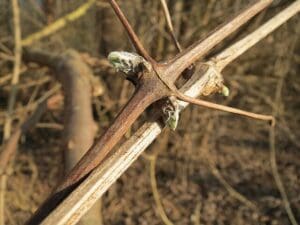
Flowers
4 petaled ( actually sepals) creamy white flowers with many prominent long white stamens growing in clusters. The flowers are small about 2cm across.
Flowers July to September
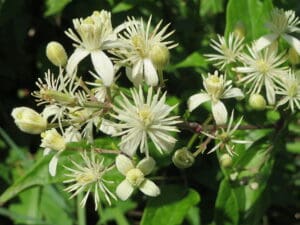
Fruit/seeds
Dry, silky fluffy looking seed heads. White/grey in colour and have a feathery appearance. Very abundant and spread by the wind. Its theses woolly looking seed heads that give the common name Old Mans Beard.
Long lasting- Autumn into winter.
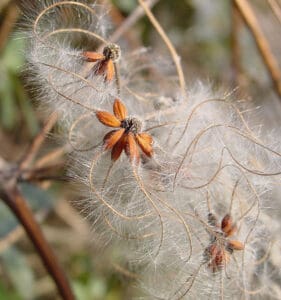
Habitat
Native to the south of England but has now spread over most of the UK apart from northern Scotland.
As this species is a vine it likes to use other shrubs and trees as its structure to grow on so is found in hedgerow and woodland. It favours chalky soils.
Known Hazards
If you wish to use it for bushcraft, getting the sap on your skin can be quite irritant, and cause blisters. We would advise wearing gloves when collecting this plant fresh. Once dried or heated this irritant diminishes.
Could Be Confused With
Honeysuckle is similar in that it is a climber and has opposite leaves. But Honeysuckles leaflets are arranged only in pairs with no single leaflet on the end like Clematis, they also have very short leaflet stalks and a smooth leaf margin.
Edible Uses
Considered generally poisonous, as is nearly the whole buttercup family.
The fresh shoots have been eaten in some countries like Italy, where is has to be boiled very well before it can be rendered edible. They call is “Vitabini” in Tuscany. However we can’t find evidence that this is completely safe.
Notes on Herbal uses
Has been used in the past to treat various conditions from migraines to rheumatism but special preparations are required such as heating or drying as fresh Clematis is not safe to be ingested or be applied to the skin and can cause slow healing blisters. With such specific preparation and there not being enough evidence to back up any medical claims or safety, it’s best left alone.
Extra notes from the Foragers
It is called Traveller’s joy because it blankets the hedgerows of the countryside with billows of beautiful feathery seed heads.
The Latin Clematis is thought to derive from the Greek word for shoot as it is a climbing plant.
It was also believed by some that Traveller’s joy did the devil’s work as it would kill other plants by out-competing them giving it a common name devils twine.
Was used to bind crops particularly sheaves of grain as it would deter mice to gnaw on it.
Medieval beggars would use Clematis vitalba’s irritant blister causing qualities to bring sores on the skin, in the hopes of achieving a more pitiable appearance for potentially charitable donations.
Clematis does have some great bushcraft uses, it can be made into rope and cordage this was made and used in Europe during the stone age. The stems can be used for weaving baskets. The woody stems of clematis makes great tinder for fire lighting.
The flowers are visited by pollinating insects during the day, such as bees and hoverflies, it is also the sole food plant for many moth species such as the pretty Chalk Carpet moth, Melanthia procellata; the Small Waved Umber, Horisme vitalbata; the Small Emerald, Hemistola chrysoprasaria.
The seed heads of this plant also provide a food source for birds, such as goldfinches.
Resources
https://www.woodlandtrust.org.uk/trees-woods-and-wildlife/plants/wild-flowers/travellers-joy
https://bugwomanlondon.com/2018/11/07/wednesday-weed-old-mans-beard/



